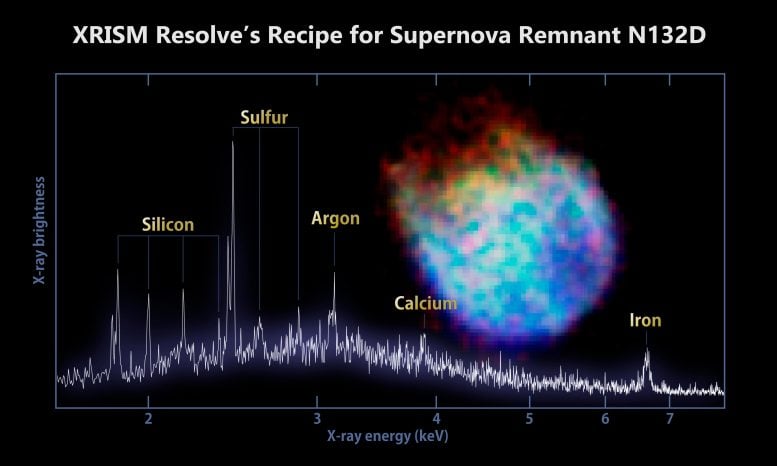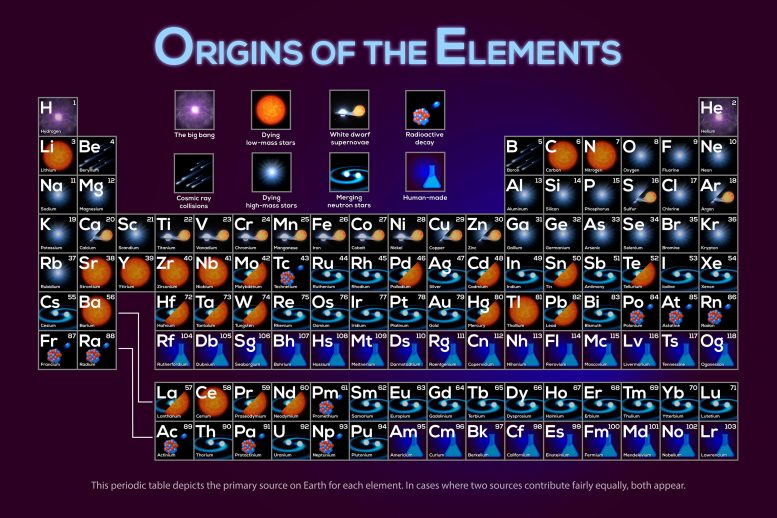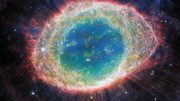
XRISM’s Resolve instrument captured data from supernova remnant N132D in the Large Magellanic Cloud to create the most detailed X-ray spectrum of the object ever made. The spectrum reveals peaks associated with silicon, sulfur, argon, calcium, and iron. Inset at right is an image of N132D captured by XRISM’s Xtend instrument. Credit: JAXA/NASA/XRISM Resolve and Xtend
XRISM’s first high-resolution spectrum of supernova remnant N132D offers unprecedented insights into the chemical and physical properties of the aftermath of a star’s explosion, enhancing our understanding of the universe’s elemental composition.
This image is the first high-resolution energy spectrum from the Resolve instrument on JAXA’s XRISM mission. It shows the energy of X-rays being produced within the remains of a massive star exploding in the nearby Large Magellanic Cloud, creating a ‘supernova remnant’ known as N132D. Spectra such as this one will enable scientists to measure the temperature and motion of X-ray emitting gas with unprecedented sensitivity and accuracy.
The spectrum indicates which chemical elements exist in N132D. XRISM can identify each element by measuring the specific energy of X-ray light that it emits (the label ‘keV’ on the x axis of the graph refers to kiloelectronvolts, a unit of energy). The ‘energy resolution’ of XRISM (its capability to distinguish X-ray light arriving with different amounts of energy) is incredible. The faint grey line shows the same spectrum from the XIS instrument on JAXA’s Suzaku X-ray telescope (source). The energy resolution from XRISM is more than 40 times better over the energy range shown in this spectrum.

This periodic table depicts the primary source on Earth for each element. In cases where two sources contribute fairly equally, both appear. Credit: NASA’s Goddard Space Flight Center
This energy range enables scientists to distinguish the elements Silicon (Si), Sulphur (S), Argon (Ar), Calcium (Ca), and Iron (Fe) – elements that are made only in supernova explosions (see graphic above). XRISM helps us measure their abundances and velocities. It also lets us put together a 3D map of the motion and distribution of the chemical elements as a result of the interaction between the supernova remnant and its surroundings. This provides clues on the nature of the explosion that created the supernova remnant, as well as on the distribution of elements that, ultimately, constitute the building blocks of planet Earth and life as we know it.
With this spectrum, XRISM separated sulfur and iron spikes that were previously indistinguishable, and it successfully detected silicon and calcium spikes with greater clarity than ever before. The incredibly sharp spectrum complements the top right image of the same supernova remnant taken simultaneously by XRISM’s Xtend instrument.









Be the first to comment on "Supernova Forensics: Unraveling N132D’s Spectral Mysteries With XRISM"